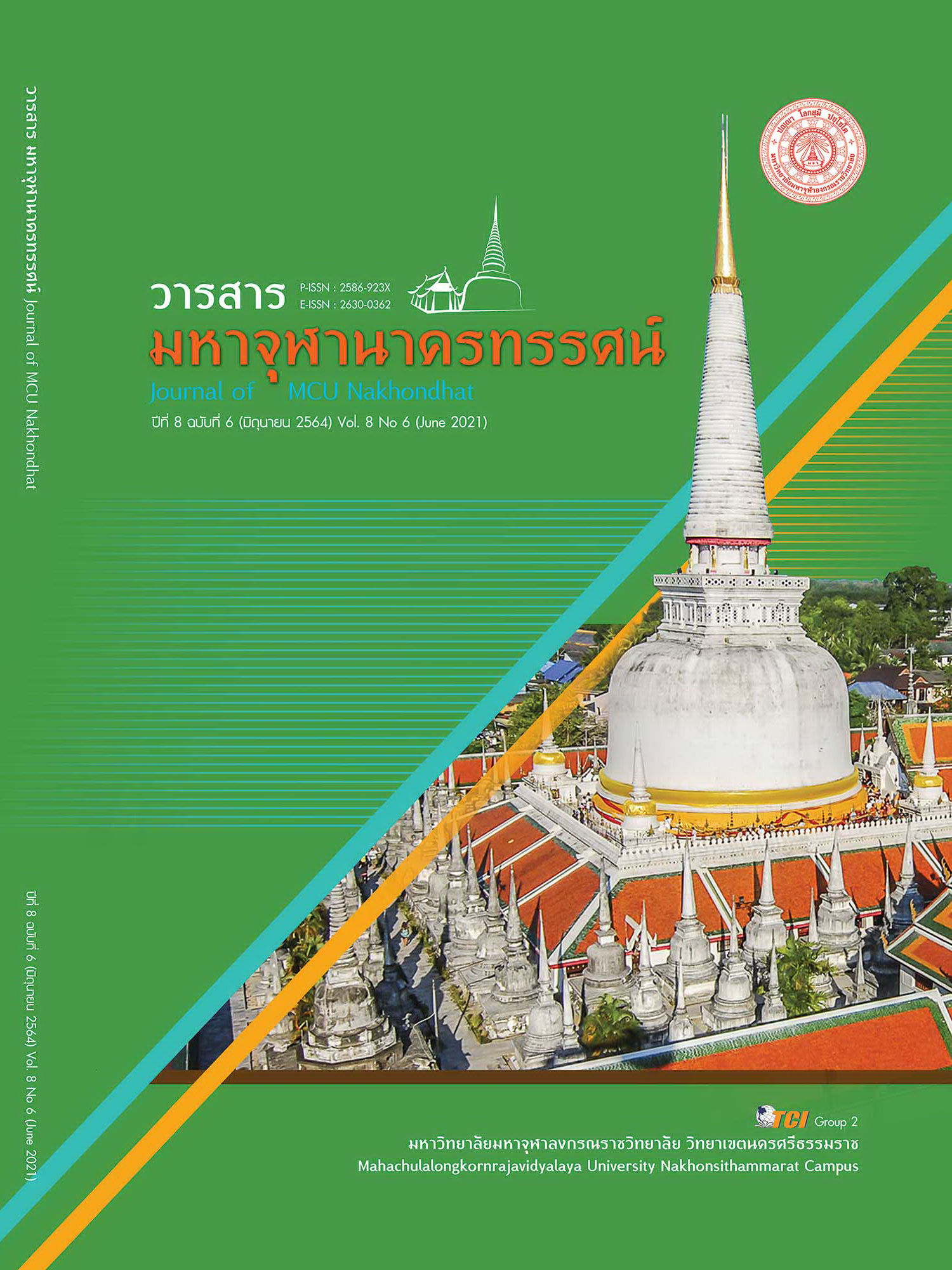ANALYTIC INSIGHT INTELLECT IN THERAVADA BUDDHISM
Main Article Content
Abstract
This article was studied of "Mahapaññākathā: analytic insight intellect" in Theravada Buddhism which was compiled systematically by Venerable Sariputta (The top Master of Intellect), Mahāpaññākathā of the Paññāvagga of the Patisambhidāmagga. It is based on the analysis of Pāli Canon which appears in Tipiṭaka, Aṭṭhakathā, Visuddhimagga, Kanthi and Nissāya. According to the Original Pāli or Pali Canon to preserve the purity of Buddha's words. It is described as the process of developing intelligence for Patisambhidā-ñāṇa (intelligence is analytic insight) which consists of attha-patisambhidā (analytic insight of consequence), dhamma-patisambhidā (analytic insight of origin), nirutti-patisambhidā (analytic insight of philology), and patibhāna-patisambhidā (analytic insight of ready wit). Especially the fulfillment of Intellect by the three principles of contemplating; (1) The seven principles of contemplating bases on Anupassana; (2) The seven principles of contemplating bases on Anupassana by the basis of 201 Dharma (phenomenon) supreme analytic or (3) The seven principles of contemplating based on Anupassana by the basic of two hundred and one Dharma supreme analytic and by a present, past and the future timeline for analytic insight Intellect. These process model of contemplation of intellect causes paññā 7th, and when complete contemplating with paññā 7th will be led to the wise or paññā 8th. Then complete contemplating with paññā 8th will be led to the dense intellect or paññā 9th. When complete contemplating with paññā 9th continue to courageous intellect or paññā 10th. Finally, after complete contemplating with paññā 10th, it would have attained Nibbāna (enlightenment) which is Sotāpanna until Arahan with the four kinds of analytic insight intellect. Besides, the obstruction of the four analytic insights and sixteen kinds of Intelligence differences (Soḷasa-paññā-nidesa and pairs of people for perspicacious analytic insight intellect differences (Puggala-visesa-nidesa) respectively
Article Details
References
พระพรหมคุณาภรณ์. (2546). พจนานุกรมพุทธศาสตร์ ฉบับประมวลศัพท์, (พิมพ์ครั้งที่ 10). กรุงเทพมหานคร: มหาจุฬาลงกรณราชวิทยาลัย.
พระพุทธโฆสเถระ. (2554). คัมภีร์วิสุทธิมรรค. แปลโดยสมเด็จพระพุฒาจารย์ (อาจ อาสภมหาเถร). (พิมพ์ครั้งที่ 10. กรุงเทพมหานคร: บริษัท ธนาเพรส จำกัด.
พระมหาสมปอง มุทิโต. (2547). อภิธานวรรณนา, (พิมพ์ครั้งที่ 2). กรุงเทพมหานคร: บริษัทประยูรวงศ์ พริ้นท์ติ้ง จำกัด.
พระอัคควังสมหาเถระ. (2549). สทฺทนีติปฺปกรณํ (สุตฺตมาลา), พระมหาประนอม ธมฺมาลงฺกาโร (ธรรมาจริยะ) ปริวรรต. กรุงเทพมหานคร: ห้างหุ้นส่วนจำกัด ไทยรายวันการพิมพ์.
มหาจุฬาลงกรณราชวิทยาลัย. (2535). พระไตรปิฎกภาษาบาลี ฉบับมหาจุฬาเตปิฎกํ 2500. กรุงเทพมหานคร: โรงพิมพ์มหาวิทยาลัยมหาจุฬาลงกรณราชวิทยาลัย.
มหาจุฬาลงกรณราชวิทยาลัย. (2539). พระไตรปิฎกภาษาไทย ฉบับมหาจุฬาลงกรณราชวิทยาลัย. กรุงเทพมหานคร: โรงพิมพ์มหาจุฬาลงกรณ์ราชวิทยาลัย.
. (2559). อรรถกถาภาษาไทย ฉบับมหาวิทยาลัยมหาจุฬาลงกรณราชวิทยาลัย. กรุงเทพมหานคร: โรงพิมพ์มหาจุฬาลงกรณราชวิทยาลัย.
ราชบัณฑิตยสถาน. (2554). พจนานุกรมฉบับราชบัณฑิตยสถาน, (พิมพ์ครั้งที่ 2). กรุงเทพมหานคร: โรงพิมพ์กรมการศาสนา.
สำนักงานราชบัณฑิตยสภา. (2560). พจนานุกรมศัพท์ปรัชญา ฉบับราชบัณฑิตยสภา. (พิมพ์ครั้งที่ 5). กรุงเทพมหานคร: สำนักงานราชบัณฑิตยสภา.
သာသနာေရးဝန္ႀကီးဌာန. (2527). ပဋိသမိ႓ဒါမဂၢထကထာဂ႑ိပဒ ပဋိသမိ႓ဒါမဂ္ပါဠိေတာ္, แปลโดยพระมหาสมชาย กิตฺติปญฺโญ. ရန္ကုန္: သာသနာေရးဦးစီးဌာန ကမ႓ာေအးစာပံုႏွိပ္တိုက္.
သာသနာေရးဝန္ႀကီးဌာန. (2560). ပဋိသမိ႓ဒါမဂၢကထာနိသျ ဒုတိယတဲြ, แปลโดย พระมหาสมชาย กิตฺติปญฺโ. ရန္ကုန္: သာသနာေရးဦးစီးဌာန ကမ႓ာေအးစာပံုႏွိပ္တိုက္.


